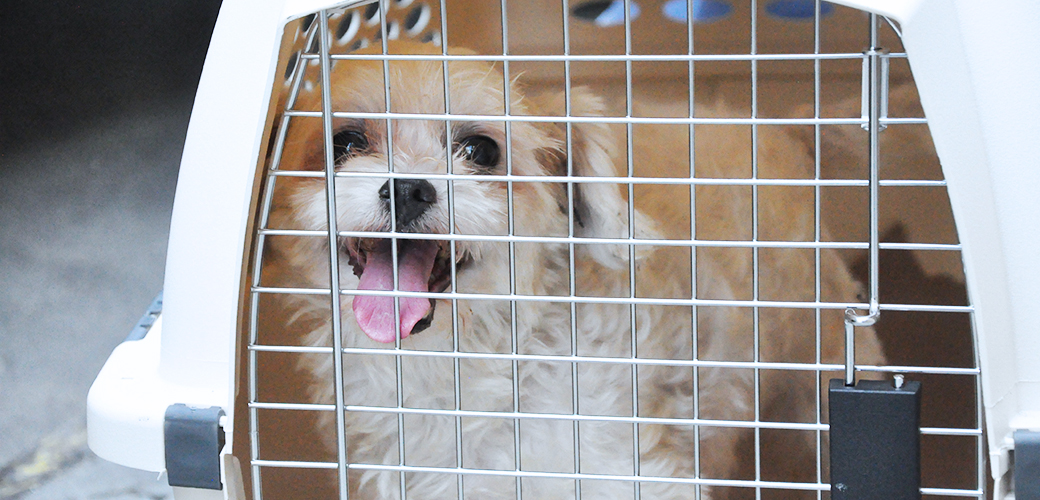#airline travel
# General Pet Care
Travel Safety Tips

For some pet parents, a trip is no fun if the four-legged members of the family can’t come along. But traveling can be highly stressful, both for you and your pets. If you’re planning to take a trip with pets in tow, we have some tips to help ensure a safe and comfortable journey for everyone.
Remember, no matter where you’re headed or how you plan to get there, make sure your pet is microchipped for identification and wears a collar and tag imprinted with your name, phone number and any relevant contact information. It’s a good idea for your pet’s collar to also include a temporary travel tag with your cell phone and destination phone number for the duration of your trip.
Traveling by plane?
Unless your furry friend is small enough to ride under your seat, it’s best to avoid air travel with your pets. If you must bring your pet along on the flight, here are a few suggestions to keep your pet safe while flying the friendly skies.
- Book a direct flight whenever possible. This will decrease the chances that your pet is left on the tarmac during extreme weather conditions or mishandled by baggage personnel during a layover.
- Make an appointment with your pet’s veterinarian for a checkup. Prior to your trip, make sure your pet’s vaccinations are up-to-date and obtain a health certificate from your veterinarian dated within 10 days of your departure. Tranquilizing your pet is generally not recommended as it could hamper his or her breathing, so use this time to check with your veterinarian for ways to relax your pet if you suspect he or she may become afraid, anxious or uncomfortable mid-flight. For travel outside of the continental United States, additional planning and health care requirements may be necessary. Contact the foreign office of the country you are traveling to for more information.
- Purchase a USDA-approved shipping crate. The crate should be large enough for your pet to stand, sit and turn around in comfortably, and lined with some type of bedding—shredded paper or towels—to absorb accidents. Prior to your trip, tape a small pouch of dried food outside the crate so airline personnel will be able to feed your pet in case he or she gets hungry during a layover. The night before you leave, freeze a small dish or tray of water for your pet. This way, it can’t spill during loading and will melt by the time he or she is thirsty. Make sure the crate door is securely closed, but not locked, so that airline personnel can open it in case of an emergency.
- Make sure your pet’s crate has proper identification. Mark the crate with the words “Live Animal,” as well as with your name, cell phone and destination phone number, and a photo of your pet. Should your pet escape from the carrier, this could be a lifesaver. You should also carry a photograph of your pet.
- Tell every airline employee you encounter—on the ground and in the air—that you are traveling with a pet in the cargo hold. This way, they'll be ready if any additional considerations or attention is needed. If the plane is delayed, or if you have any concerns about the welfare of your pet, insist that airline personnel check the animal whenever feasible. In certain situations, removing the animal from the cargo hold and deplaning may be warranted.
Taking a Road Trip?
Traveling with a pet by car involves more than just loading the animal in the back seat and motoring off, especially if you will be driving long distances or plan to be away for a long time. Here are a few car travel safety tips to help you prepare for a smooth and safe trip.
- Prep your pet for a long trip. Get your pet geared up by taking him on a series of short drives first, gradually lengthening time spent in the car. If you’re traveling across state lines, bring along your pet's rabies vaccination record. While this generally isn't a problem, some states require this proof at certain interstate crossings.
- Keep your pets safe and secure in a well-ventilated crate or carrier. The crate should be large enough for your pet to stand, sit, lie down and turn around in. Secure your pet’s crate so it will not slide or shift in the event of an abrupt stop. If you decide to forgo the crate, don't allow your pet to ride with his head outside the window, and always keep him in the back seat in a harness attached to a seat buckle.
- Prep a pet-friendly travel kit. Bring food, a bowl, leash, a waste scoop, plastic bags, grooming supplies, medication and first-aid, and any travel documents. Pack a favorite toy or pillow to give your pet a sense of familiarity. Be sure to pack plenty of water, and avoid feeding your pet in a moving vehicle. Your pet's travel-feeding schedule should start with a light meal three to four hours prior to departure, and always opt for bottled water. Drinking water from an area he or she isn’t used to could result in stomach discomfort.
- Never leave your animal alone in a parked vehicle. On a hot day, even with the windows open, a parked automobile can become a furnace in no time, and heatstroke can develop. In cold weather, a car can act as a refrigerator, holding in the cold and causing the animal to freeze to death.

|

